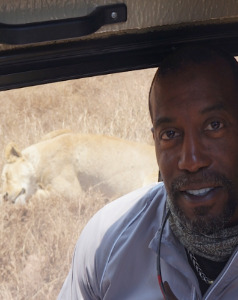
Executive coach and motivator Keith Millner proves he has what it takes to achieve a dream
Growing up on a tobacco farm where excuses were reviled and self-accountability stood compulsory gave Keith Millner the tenacity needed to follow through on his goal to climb Mount Kilimanjaro, the highest freestanding mountain in the world. Climbing more than nineteen thousand feet in Tanzania, Millner braved the altitude and terrain of Africa’s tallest peak to get a glimpse of the snowcaps which he had learned may inevitably dissolve within the next few decades due to global warming.
Millner’s ambitious approach for living is not bound to the norm, yet he doesn’t consider himself a daredevil. “People just limit themselves to various life experiences, and just to be able to say hey, I’m no different than anybody else.
It’s just something I decided to do and I went and did it. You can too,” said Millner. “It doesn’t have to be climbing a mountain, it could be learning a new skill. It could be learning a new language, anything that’s related to growing.”
His climb was nearly three years in the making and began a “bucket list” quest in celebrating his 50th birthday.

After months of preparation and searching for friends and colleagues to journey with him, finally, with sheer doggedness he trekked with likeminded strangers committed to the same goal. Even after discovering everyone in his group had withdrawn from the trip, discontinuing was not an option.
“Persistence and perseverance just comes with being a winner. Most people give up before they reach the finish line… I’ve just learned that over the years, if you just keep going, you’ll win more than you’ll lose because you’ll just outlast everybody.”
Millner said he also decided to climb Mt. Kilimanjaro because it was accessible, didn’t require any specialized skills and was safe for most healthy people. While Millner made it up the mountain unscathed, high altitudes in mountainous areas can cause some individuals pulmonary and cerebral edema, which can lead to death.
To prepare for his “once in a lifetime” expedition, Millner trained as if a marathon runner and ran five to ten miles a day. Equally, he worked to develop his leg strength and focused especially to boost his cardiovascular endurance, knowing his only indefinite was the altitude.
Getting to Mt. Kilimanjaro took four and a half days to hike up and a day and a half to walk down. In route to the mountaintop, the conveniences of heat, running water, and electricity were nonexistent.
Each day was embedded with “battling the cold,” sleep deprivation and lingering night times. Though the time difference made him intensely nocturnal, mediation, prayer and iPod-tunes helped to saturate some of his idle time, which spanned from 7 p.m. at sundown to 6 a.m. in the morning.
In addition to climbing Mt. Kilimanjaro, his 21-day excursion in Tanzania included touring “the cradle of civilization” at Oldupai Gorge, viewing the Indian Ocean in Zanzibar, taking an exotic safari and visiting with the people of the Massai tribes.
Having befriended a Massai Prince, Millner said he marveled the Massai’s astuteness to modern society while maintaining their keen entrepreneurial lifestyle and cultural devotion.
Through it all, Millner’s mantra encapsulates his resolve – “If you’re not living on the edge, you’re taking too much space!” he expressed. “For me living on the edge is just a motto to continue to motivate me and encourage me to not settle for what’s right in front of me, to avail myself to opportunities that a lot of people have but they choose not to act on.”
As a result of his conquering Mt. Kilimanjaro, Milner received unexpected benefit to his trip – a boost in his self-assurance. “My self-confidence grew exponentially! The significance being, I have always been a very confident person,” he stated. Nonetheless, he welcomes sharing his knowledge to help others garner the same buoyancy in reaching their goals.
He offers some time-tested pieces of advice when attempting to reach a goal. First is to “allow yourself to dream” and “embrace the things that you’re very interested in.” “You’ve got to have passionate dreams and goals because that passion will survive the ups and downs of your economic ability to pursue it, your familiar obligations, your work obligations; if you’re really passionate about it, you won’t let it go.”
Secondly, he advocates writing down your goals whether in a diary, on “Post-it” notes or on a ‘vision’ board. “You have to document it,” he stressed.
“Documenting your dreams has been proven to be extremely powerful and reaffirming because when you can see if you, it’s a constant reminder that hey this is something that’s in my life to do and to achieve.”
As a former athlete, Millner’s next instruction is to prepare. “In the sports world you learn that if you want to win, you have to prepare,” he stated. “And if you prepare properly, then you improve your chances of getting the outcome that you want.”
Finally and equally important, he urges others to surround themselves with “positive, affirming people” and to make personal health a priority. “If you’re around people in your life who are supportive and affirming, that is all a cumulative effect of making you feel that yes, I really can do this.”
At 52, Millner takes good care of his health by practicing moderation, and shows no signs of slowing down.
“One of my just fundamental beliefs in life is if you’re not taking care of your body, then you’re not putting yourself in a position to achieve whatever it is that you want to achieve; it all begins and ends with great health – physically, mentally, emotional, and spiritually,” he added. “I don’t know what a 52 year old is supposed to feel like. I just get up every morning and try to make the best of every day and be happy that I have the blessing to do so.”
